David's Astronomy Pages
Notes - Session 557 (2013-12-20)
Notes
(S556)
Notes
Main
Home
Page
Notes
(S559)
David's Astronomy Pages
|
Notes (S556) |
Notes Main |
Home Page |
Notes (S559) |
TPoint Mapping was conducted by using automated
routine , but with progress monitoring by indoors computer.
Mapping was curtailed when cloud began to develop and there was insufficient
stars to link/map in the last 16 attempted frames and a remaining 12 points were
cancelled
The mapping comprised :
- Initial set of 8 points within 2 arc deg distance of Altair
- a main set of points spread across the sky with limits of Dec <
68 deg and Alt > 20 deg.
A breakdown of the mapping runs is shown in
the table below.
Of the 74 target points attempted, 26 points failed (largely due to link or
map link failure due to cloud), leaving 48 points that were successfully
mapped.
Session logs showed that 2 points whilst initial linking ok (using my
enhanced link algorithm), proceeded to get a map link through TheSky.Automap
routine which can be shown to be technically invalid due to the rotation
angle of the linked image being invalid given the alignment of the camera's
CCD. This was not recognized before using the points in the TPoint Modelling
and analysis below. (Note The 2 points are not the same 2 points
that were rejected during TPoint analysis).
A further 4 points whilst initially linking ok, failed to map with Map
Failure error "Attempt to Slew beyond Dec Limit of +66 00 00.00"
This message is strange since the slew to point had already taken place by
this point. and the declination was less then 60 deg. In at least one
case the declination was 53 deg). It would seem that Map Link
had probably failed, but the error message given is somehow misplaced.
Checking the code indicates that a previous error message was being given,
and was not be updated with the actual error message.
| Map Set No. | 1) | 2) | 3) | Total |
| Set Description | Initial set of points near Altair |
1st Set of all-sky points |
2nd Set of all sky points |
|
| Programmed Points | 8 | 47 | 47 | 102 |
| Rejected points / Slew Failure (point below local horizon) | 0 | 2 | 0 | 2 |
| Rejected points / Beyond Hard-Code Dec Limit | 0 | 7 | 7 | 14 |
| Cancelled points (due to cloud) | 0 | 0 | 12 | 12 |
| Imaged Points | 8 | 38 | 28 | 74 |
| Mapped Points (*) | 8 | 27 | 11 | 48 |
| Failed Points | 0 | 11 | 17 | 26 |
| Map Success Rate | 8 /8 (100%) |
27 /38 (71%) |
11 / 28 (39%) |
46 / 74 (62%) |
| Reasons for map failure | ||||
| Link Failure due to cloud | 0 | 3 | 16 | 19 |
| Map Link Failure | 0 | 6 | 6 | 7 |
| Mapping that should have been rejected due to discrepancy in rotation angle (*) | 0 | (2) | 0 | 2() |
Across the entire sky the RMS error without
model was determined to be 8.6 arc min.
This compares fairly closely with an RMS slew error of 6.1 arc min for 60
targets during an observing session without TPoint three weeks before (2013-11-01
S552). Of these points around 50% had errors in the range 6 - 10 arc mins,
and the targets were probably less spread-out, than the mapping targets.
12 alternate TPoint models were created
with generally progressively lower RMS and PSD (see table
below).
Using 12 terms including Tube Flexure, MA, ME and four harmonic terms
(Model 8) reduces the RMS error to 0.9 arc min.
Adding further additional harmonic terms (Models 9 & 10) doesn't produce
any improvement in fit (in fact the the match deteriorates)
Since the LX-200’s control system does
refraction calculations automatically, Pressure and Height were set to zero
in the Observing Parameters dialog in order to forces TPoint to ignore its
refraction calculations.
Model Description RMS PSD Notes 0a 48 points, with 0 terms 638 638 one point (#12) has value of > 2000 arc secs and can be flagged as erroneous.
With this point excluded the RMS error falls to 515 arc sec. (8.6 arc min)
0b 78 points, with 0 terms 515 515 8.6 arc min RMS with no TPoint model, Point #12 excluded 1 48 points, with 6 terms
(6 equatorial terms)517 553 one point (#12) has value of ~ 2000 arc secs and can be flagged as erroneous.
2 47 points with 6 terms
(6 equatorial terms)422 453 3 47 points with 8 terms
(6 equatorial terms, plus Fork & Tube Flexure)165 181 one point (#25) has value of ~950 arc sec and can probably be treated as erroneous
Tube Flexure is more significant term. RMS is 334 without it, compared to 169 without Fork Flexure4 46 points with 8 terms
(6 equatorial terms, plus Fork & Tube Flexure)92 101 Polar Misalignment
Azimuth (MA -69, sigma 19). Need to rotate polar axis east (clockwise) by 2.1 mins
Altitude (ME +198 sigma 60). Need to raise polar axis by 3.3 mins5 46 points with 12 terms
(6 equatorial terms, plus 6 top harmonic terms)84 97 Polar Misalignment
Azimuth (MA -73, sigma 17). Need to rotate polar axis east (clockwise) by 2.3 mins
Altitude (ME -289 sigma 30). Need to lower polar axis by 4.8 mins6 46 points with 12 terms
(6 equatorial terms, plus Fork & Tube Flexure, plus
4 top harmonic terms)59 69 Polar Misalignment
Azimuth (MA -73, sigma 12). Need to rotate polar axis east (clockwise) by 2.3 mins
Altitude (ME +114 sigma 80). Need to raise polar axis by 1.9 mins7 46 points with 12 terms
(6 equatorial terms, plus Tube Flexure, plus
4 top harmonic terms)57 67 Polar Misalignment
Azimuth (MA -68, sigma 12). Need to rotate polar axis east (clockwise) by 2.1 mins
Altitude (ME +133 sigma 75). Need to raise polar axis by 2.2 mins8 46 points with 12 terms
(6 equatorial terms, plus Fork & Tube Flexure, plus
4 top harmonic terms)55 64 0.9 arc min RMS -
Polar Misalignment
Azimuth (MA -69, sigma 11). Need to rotate polar axis east (clockwise) by 2.1 mins
Altitude (ME +161 sigma 60). Need to raise polar axis by 2.7 mins9 46 points with 14 terms
(6 equatorial terms, plus Fork & Tube Flexure, plus
6 top harmonic terms)59 71 0.98 arc min RMS
Polar Misalignment
Azimuth (MA -73, sigma 12). Need to rotate polar axis east (clockwise) by 2.2 mins
Altitude (ME +117 sigma 80). Need to raise polar axis by 2.0 mins10 46 points with 16 terms
(6 equatorial terms, plus Fork & Tube Flexure, plus
8 top harmonic terms)59 73 0.98 arc min RMS
Polar Misalignment
Azimuth (MA -73, sigma 11). Need to rotate polar axis east (clockwise) by 2.3 mins
Altitude (ME +112 sigma 60). Need to raise polar axis by 1.9 mins11 46 points with 12 terms
(6 equatorial terms, plus
6 top harmonic terms)52 61 0.87 arc min RMS
Polar Misalignment
Azimuth (MA -76, sigma 10). Need to rotate polar axis east (clockwise) by 2.4 mins
Altitude (ME +42 sigma 35). Need to raise polar axis by 0.7 mins12 46 points with 13 terms
(6 equatorial terms, plus
6 top harmonic terms, plus Tube Flexure term)51 60 0.85 arc min RMS with ?best TPoint Model
Polar Misalignment
Azimuth (MA -74, sigma 11). Need to rotate polar axis east (clockwise) by 2.3 mins
Altitude (ME +110 sigma 60). Need to raise polar axis by 1.8 mins
|
Data Fit, Fit Information and Polar
Misalignment Information |
Data Fit, Fit Information and Polar
Misalignment Information for Model 11 (46 points with 12 terms: 6 equatorial terms, 6 top harmonic terms) |
|
|
|
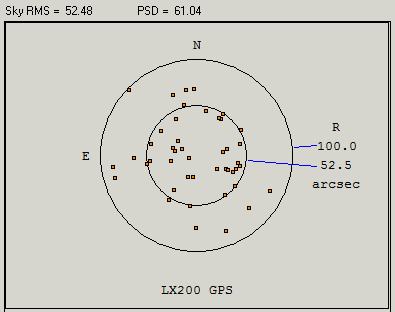 |
|
|
|
|
|
|
|
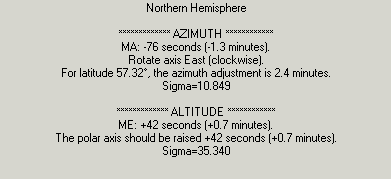 |
Back to Top
The TPoint mapping run described above was used to analyze the Polar Alignment of the LX200 Mount
The Polar Alignment indicated by alternate
TPoint models is fairly consistent in Azimuth (MA -68 to -73) but
there is more uncertainty in Altitude ( ME between +42 and +198).
It is noted that excluding tube flexure and including more harmonic terms it
is possible to get a similar low overall RMS value, but with a negative ME
value of -289. This is significantly different : models that
include tube flexure suggest raising the polar axis whilst the the model
that excludes Tube Flexure suggests lowering the polar axis.
However in creating the alternate models it was very obvious that Tube
Flexure term single handedly improved model fit to data more than any other
single term.
[The TPoint Users Guide states that additional harmonic terms must be
added to the TPoint model for the polar alignment information to be
accurate. When you can achieve 30- to 40-arc seconds RMS value by using the
Suggest Terms (Add Harmonics dialog box) you will have accurate polar
alignment information from TPoint.]
Test suggest the optimum data fit comes with 4 additional harmonic terms
(Model 8)
ME/MA values indicate that Polar Axis should be rotated clockwise by 2.1 arc
mins and raised by 2.7 arc mins.
Several models suggest raise the Polar
Axis by only 1.9 to 2.2 arc mins, ount
Looking at advice from Tom Bisque on Software
Bisque Tom's Corner
Do not add the tube flexure term until after you
have added additional terms. As is the case with the polar alignment
information reported BEFORE adding any additional terms the data cannot be
fully trusted. Try fixing the system with several additional terms using the
terms wizard first then add the Tube Flexure term LAST. You may even find it
does little to nothing!
Models 11 and 12 (either not adding Tube Flexure or adding it last) as
suggested by Tom Bisque's advice, would suggest raising Polar Axis by only
0.7 to 1.8 arc mins. With this in mind it is
it is proposed to make the following
changes to the mount, on the next suitable night
| Action |
| Rotate polar axis eastwards by 2.3 arc mins (i.e. clockwise) |
| Raise polar axis by 1.5 arc mins |
The planned procedure is as follows
| Code | Actions | Notes |
| 1 | Slew to suitable starfield in southern sky (close to Dec 0), | Should contain a reasonably bright star for quick 1sec frames during mount/wedge adjustment and sufficient stars in a 5-10s image for getting a good image link |
| 2 | Take 5-10s Baseline image and perform image link | From this we can determine the scope's precise position before adjustment (this provides some safety in the event that star position is lost during adjustments to the mount/wedge. |
| 3 | Determine altitude of the bright star in image | |
| 3 | Jog Scope to move the bright star to a position that is precisely cosine (altitude) * 2.3 arc min west of CCD image centre (see note) and 1.2 arc min south of the image centre (For a south-up raw imaging star will be to position to upper left of image centre). | We position star to west
of image center so that star will be re-centered when mount is
rotated clockwise We position star to south of image center so that star will be recentered when polar axis is raised, (which causes our southerly directed scope to move south |
| 4 | take 5-10s image, perform image link | Compare to baseline image and confirm that star is in correct starting position |
| 5 | without jog scope or using handset, adjust wedge and mount so that star becomes precisely re-centred in the image. | |
| 6 | take final 5-10s image, perform image link | Compare final image with base line image and confirm that required adjustment has been made |
From my latitude a star positioned on
meridian at Dec 0 will have an altitude of 32.68
(90-57.32). Since Cosine (32.68) is 0.8417
This means that scope nthe eeds to be pointing 1.94 arc min east of star
(from 2.3 x 0.8418) before polar adjustment begins.
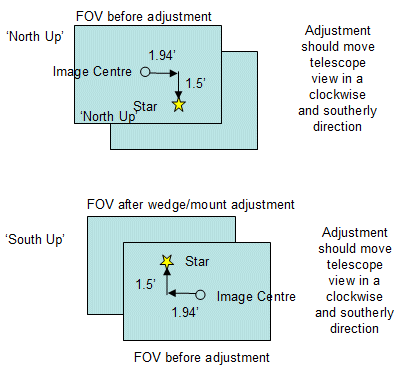
Back to Top
A star at Dec 0 in the southern sky was monitored for 16 mins,
during which time the star drifted westwards at an overall rate of around 0.7 arc
secs/min.
This means that scope is tracking too slowly.
The star was then monitored for a 3 further 16 min periods during which
the star continued to drift westwards at overall rates of 1.3 arc sec/min, 0.5
arc sec/min, and 1.0 arc sec/min
The mean rate of drift over the 4 intervals is westwards at 0.9 arc sec/min (ie - 0.9 arc sec/min)
During these intervals the precise star position was analyzed at 13 sec intervals. This provided 161 measurements of the tracking drift over approximately 8 minute period intervals (see graph below). Mean drift was 0.97 arc sec/min (range 0.0 to 2.3, SD 0.47).
![]()
Scatter is graph data assumed to be due to a mixture of residual periodic error and imperfections in the RA gear. An overall tracking drift of -0.9 arc sec/min is generally supportable. In order to speed up the scope a positive tracking rate adjustment is required. This would normally be +0.9 (in practice +1), but since the x10 finer tracking rate patch has been included in the Autostar II firmware upgrade to 4.2G, the required tracking rate adjustment is +9.
Tracking Rate in Autostar II was duly updated to
a custom value of +9.
The setting will be checked at start of next session to confirm that the
tracking rate has been preserved between power cycles.
Notes collected from Internet : The *unpatched* tracking rate adjustment is very close to being units of "arcseconds of drift per clock minute" So if a star drifts eastward (i.e. scope too fast) two arcminutes in 15 wall-clock minutes, you'd want to use a Custom value of 2*60 (to give arcseconds) divided by 15 (clock minutes): 2*60/15=8 Since the scope is "too fast", you want a negative Custom value to slow it down. So "-8" is the desired setting. If you have the patch installed, that becomes -80.
The (unpatched) Tracking Rate Custom is in units of
tenths of a percent compared to (what the Autostar calls) normal
sidereal. Part of the 10x Finer patch is a change of the prompts
from: 'Enter Rate Adj.' to '.01%'s sidereal'
If the polar axis is off by (say) 0.5 deg, the tracking rate could be
out by a factor of cos(0.5) = 0.99996.
Back to Top
In the previous session (S556b) it was estimated that Tracking rate was running too slow by 0.09% of sidereal and a Custom RA Tracking Rate adjustment of +9 was entered into Autostar II before parking the scope and powering down. Normally (with 4.2g firmware) the tracking adjustment would be lost when scope was powered down, but with the upgrade to 4.2G it was expected that the settings would be retained to the next session.
Session S557 began by examining the RA tracking setting in Autostar II - it showed Custom Tracking with a value of +9. This indicated that the setting had apparently been preserved as expected. However there remains some uncertainty whether the saved Custom Tracking Rate is actually being correctly applied from start-up.
Initial tracking rate measurements (8 min moving average) showed that a star at Dec 0 in the southern sky was drifting west at 3.5 arc secs/min. Whilst some variation in measurements was expected (S.D. of 0.5 over 8 min period determined in the last session), the difference from expectation (which was no or little drift) was unreasonably large. The initial thought was that I must have the sign wrong, and made a second run with tracking rate adjustment set to -9. In this run the star drifted west at -1.8 arc secs/min. Further runs were then made with tracking rate adjustment set to +29, +20, +14, +13.
Results of these runs and the previous runs from last session are shown in the graph below. A best fit line shows that correct sidereal tracking tracking requires a tracking rate adjustment of +11. This compares reasonably well with the estimate of +9 from the previous session.
![]()
Although the scope had been powered down at end
of last session with a Tracking Rate adjustment of +9 it behaved on power up as
if it had a tracking rate adjustment of around -20 (despite showing a value of
+9 on the Autostar II screen).
The scope was powered down at end of session S557 with a Tracking Rate
adjustment of +13. Tracking rate will again be examined at start of
next session to test whether the problem was just a first use issue or whether
the problem is more persistent. After this the tracking rate will be
set to +11 and the Tracking Rate measured again. Residual Periodic Error
(after PEC corrections) will mean that tracking will never be perfect, however
the aim is to use a RA tracking rate adjustment that cancels the mean RA drift.
Back to Top
Polar alignment adjustment was made in both azimuth and altitude based on the misalignment estimates made in previous session

Star in southern sky at approximately Dec 0 was centered in the FOV. The scope was then jogged by required amounts in RA and Dec. Finally azimuth and altitude adjustments to wedge were made to recenter the star. Process is illustrated by the following pictures (South Up).
| Star centered in field of view |
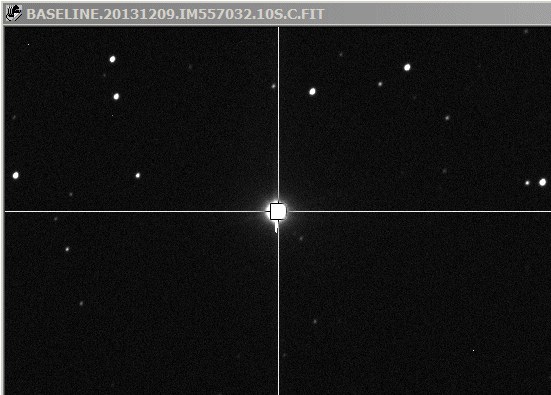
|
| Scope jogged north by 1.5 arc min and east by 1.9 arc min |
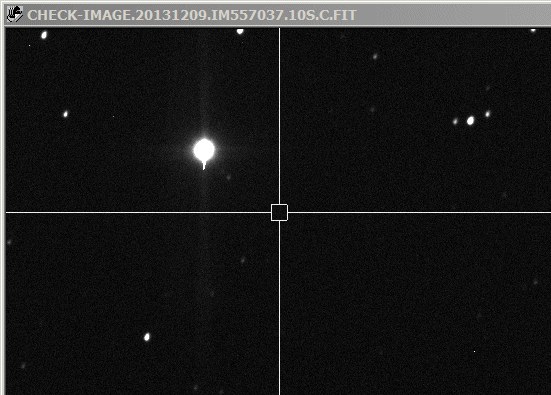
|
| Mount adjusted south
by ~1.5 arc min and west by ~ 1.9 arc min (Image affected by wind shake to scope) |
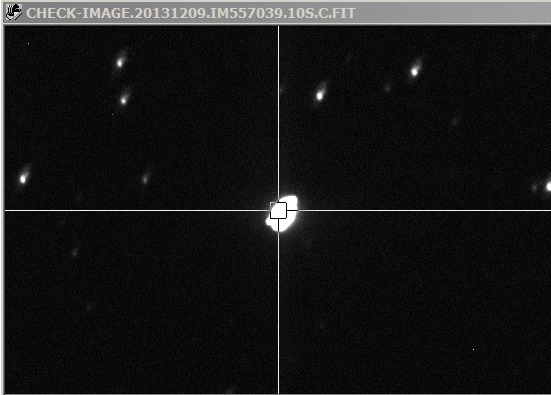
|
| CCD Images (50% size) 10s exp, 2x2 binning, C Filter |
Back to Top
| This Web Page: | Notes - Session 557 (2013-12-20) |
| Last Updated : | 2015-05-15 |
| Site Owner : | David Richards |
| Home Page : | David's Astronomy Web Site |